Culture of Maldives
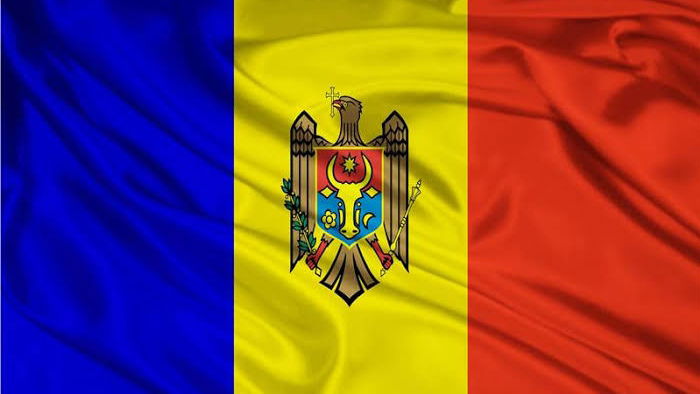
Culture Name
Maldivian
Orientation
Identification. The Maldives is one of the world's poorest developing countries. It is threatened by global warming because of its very low elevation. The main natural resources are fisheries and a marine environment conducive to tourism. The other constraints it faces are small and widely dispersed island communities, limited skilled human resources, and rapid population growth.
Location and Geography. The Republic of Maldives is an archipelago consisting of twenty-six coral atolls, in the northern Indian Ocean. The chain of islands extends 510 miles (820 kilometers), but occupies an area of just 116 square miles (300 square kilometers), roughly 1.5 times the size of Washington D.C. The closest neighbors are India and Sri Lanka. The capital is Malé.
The twenty-six coral atolls contain 1,190 very small islands of which 198 are inhabited. Most of the islands are close to the atoll enclosure reef, and some are still in the process of forming. The longest is Gan in Adu atoll. Because the islands are coral-based, they are flat and low-lying. As a result, the water table is high. However, the islands are protected from the elements by the reef and rarely have major storms. In the older islands a larger layer of topsoil has formed, and these islands are covered with coconut trees, breadfruit, and dense shrubs. Agricultural potential is limited by the high alkalinity of the soil and its poor water retention. However, people grow vegetables, fruits, and yams.
The climate is warm and tropical. Seasonal changes are determined by the two yearly monsoons. The season of the northeast monsoon is characterized by dry, mild winds, and generally extends from December to April. The southwest monsoon, although irregular, extends from May until August and brings heavy rains and wind. The northern atolls are drier, while the southern atolls are wetter. The humidity is fairly high throughout the year.
Demography. In 1996, the population was 256,157, compared with 195,000 in 1986; the estimated population for the year 2000 is 289,117. The annual rate of population growth is almost 3 percent. Almost most half the population is under fifteen years of age, and about 3 percent is sixty five years and older. About 25 percent of the population reside in Malé. The growth rate in Malé atoll has been high as a result of employment opportunities offered by growth in the service sector. Even though income in Malé is significantly higher than that in the atolls, the resulting rural-urban migration has led to increasing unemployment. Emigration from the republic is rare except for educational purposes or to work as a crew member on Maldivian ships.
Linguistic Affiliation. Dhivehi, which is spoken in all parts of the country, is not spoken in any other part of the world. It is considered an Indo-European language related to Singhala, the language spoken in Sri Lanka. The alphabets and writing system are similar to Arabic. English is the second language and is widely used in commerce and in many government schools.
Symbolism. The national flag is red with a large green rectangle in the center bearing a vertical white crescent on the hoist side. The country is associated with the "maldive fish" (boiled sun-dried tuna).
History and Ethnic Relations
Emergence of the Nation. The early settlers probably came before 500 B.C.E. , from Sri Lanka and southern India. In the twelfth century, sailors from East Africa and Arab countries arrived. Originally, Maldivians were Buddhists, but in the twelfth century Islam was proclaimed the national religion. The
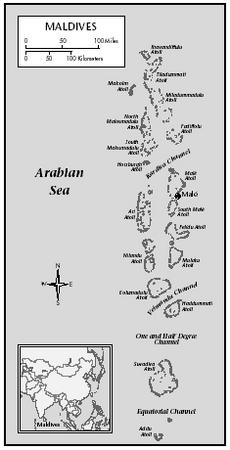
Maldives
Maldives has always been an independent political entity except when it was under Portuguese control from 1558 to 1573. In 1887, the Maldives agreed to become a protectorate of the British government, allowing the British to take responsibility for it defense and foreign relations while maintaining for itself internal control. The first constitution was ratified by the Sultan in 1932, and the sultanate became an elected rather than hereditary position.
National Identity. The Maldives regained full sovereignty in 1965 and joined the United Nations that year. In 1968, the sultanate was abolished and the republic was declared. On 11 November 1968, the Republic of Maldives was created with an elected president. The country joined the British Commonwealth in 1982.
Ethnic Relations. The population consists of a mix of people who trace their descent from Sri Lanka, India, Arab countries, and Africa. Because of religious and linguistic homogeneity, there is stability and unity.
Urbanism, Architecture, and the Use of Space
Malé is the center of political and economic life. It has a maze of narrow streets with over twenty mosques and markets. Poor people live in houses built from thatched palm with tin roofs, and the more prosperous have houses made of crushed coral with tile roofs. The main attractions are the National Museum, which displays items from Arab, Sri Lankan, and Dravidian cultures; Sultan Park; the Islamic Centre; and the gold-painted Grand Friday mosque. The oldest mosque, Hukuru Miski, is known for its intricate stone carvings.
Food and Economy
Food in Daily Life. Rice and fish are the staple foods. Fish is the most important source of protein in the average diet. Very few vegetables are eaten. Betel leaf with arecanut, cloves, and lime, known as foh, is chewed after meals. Old people smoke guduguda, an elongated pipe that goes through a trough of water. Most food served in tourist resorts is imported.
Food Customs at Ceremonial Occasions. Meat other than pork is eaten only on special occasions. Alcohol is not permitted except in tourist resorts. The local brew, raa , is a sweet toddy made from the crown of the coconut palm.
Basic Economy. All the fish that is consumed locally is from the domestic economy. Basic food commodities such as rice, sugar, and flour are imported. There are over seventy resort islands near the capital.
Land and Tenure and Property. Land belongs to the state and is given free to families in the island of their origin to build houses. The only exception is that public servants lease land where they work. In other islands, where tourist resorts, a cannery, the airport, and other small industries are located, employees are provided with temporary accommodations.
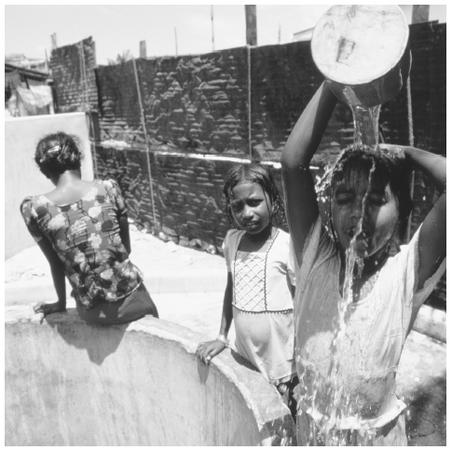
Young girls gather at a well. Almost half of the country's population is under fifteen years of age.
Commercial Activities. Because of the limited land mass, the main prospect for economic development is the country's marine resources. Fisheries, tourism, trade, and transport (shipping) constitute the principal economic base.
Major Industries. Fisheries and international tourism are the main industries. The economy has changed from a reliance on fisheries to a service-sector-based economy driven by international tourism. The main primary sector is fishing. The secondary sector consists of construction and manufacturing. In the tertiary sector, tourism, government administration, and transport are the dominant industries. Manufacturing output consists primarily of processed fish; apparel and clothing; cottage industries such as woven mats, coir rope, and handicrafts; and boat building industries.
Trade. In addition to food, the country imports manufactured goods such as petroleum products and various consumer goods. In 1997, these products were imported primarily from Singapore, India, Sri Lanka, the United Arab Emirates, Malaysia, and the United Kingdom. About 80 percent of exports consist of frozen, dried, and salted skipjack tuna; canned fish; dried shark fins; and fish meal. A small manufacturing export sector exports apparel and clothing accessories. In 1997, the leading destinations for exports were the United Kingdom, the United States, Sri Lanka, Japan, and Singapore.
Division of Labor. There were approximately sixty-four thousand members of the Maldives workforce in 1999, one-third of whom were foreign workers. About 20 percent of the workforce in 1999 worked in the fishing industry; 15 percent in industry; 10 percent in tourism, and 55 percent in other sectors. The minimum working age is fourteen (sixteen for government work).
Social Stratification
Class and Castes. A disproportionate share of government expenditures directly benefits Malé and ensures its residents a standard of living that is substantially higher than that in the atolls. Status is derived primarily from wealth rather than family, although family ties and connections are important in determining the availability of opportunities. One's position with the government also confers status, while education is less important.
Political Life
Government. The legislative assembly known as the Majlis is composed of fifty members: two from Malé, two from each of the twenty administrative atolls, and eight appointed by the president. The speaker of the Majlis is not a member of that body and is appointed by the president. Even though all the members have the right to attend sessions and speak at the Majlis, only elected members can vote. The right to vote is universal for those age twenty one years and over. The head of the government is the president who is nominated in a secret ballot by the Majlis, and then elected by a majority vote at a national referendum for a five-year term. The president appoints the ministers and all judges to the courts. The high court consists of a chief justice and four judges.
The executive branch is divided into the president's office, the attorney general's office, and seventeen ministries and associated entities that implement government programs. The ministries of government, the attorney general's office, and the high court all function under the president's office. The current president is also the governor of the central bank.
Leadership and Political Control. The government appoints an atoll chief who exercises the government power. Each island has an island chief appointed by the government who is the administrative head of the island. The atoll offices and the island offices come under the Ministry of Atoll Administration, which is responsible to the president.
Social Problems and Control. Historically, the society has been closely knit and disciplined as a result of unity of religion (Sunni Muslim) and language. Although there was civil unrest in the past, it was mostly related to power struggles within the government, and the stormy relationship between Maldives and the British government prior to the termination of Britain's military presence in the islands in 1976.
Military Activity. The country maintains only one security unit, the National Security Service. This organization has about 1,800 personnel who perform army, police, and maritime duties. Because of the geographic spread of the islands, it is impossible to have a military presence on every island and for the coast guards to protect the area. Since independence, the country has not faced any external threats.
Social Welfare and Change Programs
The government has focused its spending on social services and preventive health services. There is no organized social welfare system. Assistance is traditionally provided through the extended family. Employees are entitled to medical and maternity leave.
Gender Roles and Statuses
Division of Labor by Gender. Over 25 percent of women are employed, primarily by the government. The government sector employed 15,862 people in 1996, approximately 64 percent males and 36 percent females. Women in the atolls generally are employed only in domestic or selected duties within the family, such as tending crops and producing general handicraft items such as coir rope and woven coconut palm leaves for domestic use. Women also collect cowrie shells from the shores.
The Relative Status of Women and Men. Women make a significant contribution to social, political and economic affairs. The economic sectors in which women are employed are education, health and welfare, services, tourism, transport, and communication.
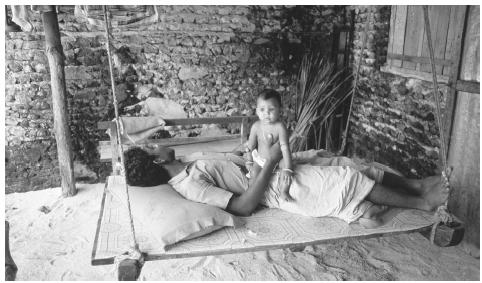
A Himmafushi Island man relaxes with his child. Most Maldivian households consist of nuclear families.
Marriage, Family and Kinship
Marriage. The legal age for marriage is eighteen, although half of the women marry by age fifteen. Marriages are not arranged. In accordance with Islamic law, a man can have four wives at any time if he can support them financially, but polygamy is uncommon. Sex before marriage is a punishable offense. Marriages can take place only between Muslims. Maldives has one of the highest divorce rates in the world; according to a 1977 census, nearly half of the women over the age of thirty had been married four times or more.
Domestic Unit. Unlike households in many other Muslim countries, households in Maldives typically do not include extended family members. Nuclear families consisting of a married couple and their children comprise roughly 80 percent of the households, with the father typically recognized as the head of the family. Unmarried persons generally live with their families rather than by themselves.
Inheritance. Both men and women may inherit property.
Kin Groups. The island communities outside of Malé are generally close-knit, self-contained groups in which most everyone is related through generations of intermarriage.
Socialization
Child Rearing and Education. Primary level education is for five years and secondary education is in two stages: five years at the lower level and two years at the higher level. Education is not compulsory. There are three streams of Maldivian education: traditional religious schools (makhtabs), which teach the Koran (Qur'an), basic arithmetic, and the ability to read and write Divehi; modern Divehi-language primary schools; and modern English-language schools. Primary and secondary schooling is based on the British educational system.
In 1998 there were 48,895 students enrolled in 228 primary schools, with 1,992 teachers. In the same year, secondary schools had a total of 36,905 students.
Higher Education. Maldivians must go abroad for higher education. Currently the Science Education Centre in Malé provides pre-university courses, and the Centre may evolve into a university.
Etiquette
Maldivians are brought up to respect elders and those who are educated while conforming to an Islamic
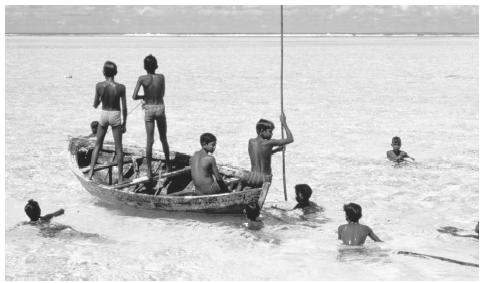
A group of boys fish in the shallow waters off the Maldives Islands. In addition to being an important food source, fish is the nation's greatest export.
code of conduct. Strong loyalties tie the individual to the extended family.
Religion
Religious Beliefs. Islam is the only national religion; no other religions are permitted. All Maldivians belong to the Sunni sect. Only Muslims may become citizens, marry, or own property in Maldives, and daily life is regulated according to the tenets of Islam. The widespread belief in jinns, or evil spirits, has resulted in a blending of Islam with traditional island beliefs into a magico-religious system known as fandita.
Religious Practitioners. The political, judicial, and religious systems in Maldives are so closely intertwined that the political leaders and judges are also the country's religious leaders. The president is considered the primary religious leader, and judges, known as gazis, are responsible for interpreting Islamic law in the courts.
Rituals and Holy Places. Most holidays are based on the Islamic lunar calendar. In addition to the Golden Grand Friday mosque, twenty other mosques are scattered around Malé. Mosques are also found in each of the islands. In Malé, a graveyard holds the tomb of Abu Al Barakat, a North African Arab who brought the Koran to the Maldives in the twelfth century. He later became the first sultan. Also located in this graveyard are tombstones of all the former sultans.
Death and the Afterlife. In accordance with the Islamic faith, the people of Maldives believe that people go to heaven or hell after death, depending on how faithfully they adhered to the five tenets of Islam while still alive. Believers are considered worthy to enter heaven if they were faithful to repeat the creed "There is no God but Allah, and Muhammad is the prophet of Allah"; fast during the month of Ramadan; pray five times every day; give alms to the poor; and, if possible, make a pilgrimage to the holy city of Mecca sometime during their lifetime.
Medicine and Health Care
Improved health services have decreased the infant mortality rate and the general death rate. Life expectancy increased to seventy-one years, from sixty-one years between 1986 and 1996. The birth rate per thousand dropped from forty-five in 1986 to twenty-six in 1996.
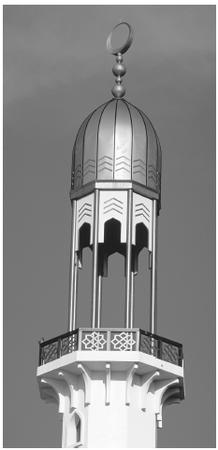
The minaret of a mosque on the island of Malé, the principal island in the Maldives. Islam is the only religion permitted in the country.
Secular Celebrations
Kudaeid celebrates the sighting of the new moon at the end of Ramadan, and the Prophet Mohamed's birthday is also celebrated. National Day, the day Mohammed Thakurufaan overthrew the Portuguese in 1573, occurs on first day of the third month of the lunar calender. Victory Day on 3 November celebrates the defeat of the Sri Lankan mercenaries who tried to overthrow the government. Republic Day on 11 November commemorates the foundation of the current republic.
Bibliography
Adney, M., and W. K. Carr. "The Maldives." In J. M. Ostheimer, ed. The Politics of the Western Indian Ocean Islands, 1975.
Anderson, R. C., and A. Hafiz. The State of the Maldivian Tuna stock: Analysis of Catch and Effort Data and Estimation of Maximum Sustainable Yield, 1985.
Cole, R. V. "The Island States of the Indian Ocean: A View from the South Pacific." Pacific Economic Bulletin 1 (2): 41–46, 1986
Fifth National Development Plan 1997–2000, 1998.
Maniku, H. A. The Republic of Maldives, 1980.
Ministry of Planning, Human Resources and Environment. Statistical Year Book of Maldives, 1998.
Sathiendrakumar, S. Development of Resources of the Sea for Regional Cooperation and National Development, 1983.
——. "Artisanal Fisheries, Tourism and Development: Economic Analysis of the Maldives and Fishing-Boat Mechanisation." Ph. D. Thesis, University of Newcastle, New South Wales, Australia, 1988.
——. "An Appropriate Management Policy for the Tuna fishery in the Maldives." Asian Fisheries Science 2: 163–175, 1989.
——. "Marine Areas as Tourist Attractions in the Southern Indian Ocean." In M. L. Miller, and J. Auyong, eds., Proceedings of the 1990 Congress on Coastal and Marine Tourism, 1990.
——. "Problems Faced by Indian Ocean Island Economies: The Case of the Maldives." In R. Gabbay, R. N. Gosh, and M. A. B. Siddique eds., Economics of Small Island Nations, 1996.
——. "Environmental Management for Sustainable Economic Development in Island Economies: The Maldivian Experience." In K. C. Roy, H. C. Blomqvist, and Hossain Iftekhar, eds., Development That Lasts, 1997.
——, and C. A. Tisdell. "Tourism and the Development of the Maldives" Massey Journal of Asian and Pacific Business 1 (1): 27–34, 1985.
——. "Fishery Resources and Policies in the Maldives: Trends and Issues for an Island Developing Country." Marine Policy 10 (4): 279–293, 1986.
——. "Optimal Economic Fishery Effort in the Maldivian Tuna Fishery: An appropriate Model." Marine Resource Economics 4 (1): 15–44, 1987.
——. "Migration from Traditional Rural Communities and Outside Employment: A Study of Maldivian Fishing Villages." South East Asian Economic Review 8 (2): 121–63, 1987.
——. "Towards and Appropriate Effort-Based Fishery Model for the Tuna Fishery of Maldives." Indian Journal of Fisheries 34 (4): 433–454, 1987.
——. "The Maldives: Development and Socio-Economic Tensions." South East Asian Economic Review 9 (2): 125–162, 1988.
——. "Economic Importance of Tourism for Small Indian Ocean and Pacific States." In C. A. Tisdell, C. J. Aislabie, and P. J. Stanton, eds., Economics of Tourism: Case Studies and Analysis , 1988.
——. "International Tourism and the Economic Development of the Maldives." Annals of Tourism Research 16 (2): 254–264, 1989.
——. "Determinants of Relative Wealth in Maldivian Fishing Villages." Asian Profile 17 (2): 155–168, 1989.
——. "International Tourism and the Economic Importance of an Archipelago: The Case of the Maldives." In J. L. Kaminarides, Briguglio, and H. Hoogendonk, eds., The Economic Development of Small Countries: Problems, Strategies and Policies, 1989.
——. "Technological Change and Income Distribution: Findings from Maldivian Fishing Villages." Journal of Economics and International Relations 3 (3): 217–240, 1990.
World Bank. The Maldives: An Introductory Economic Report, 1980.
——. Fishery: Sector Policy Paper, 1982.
